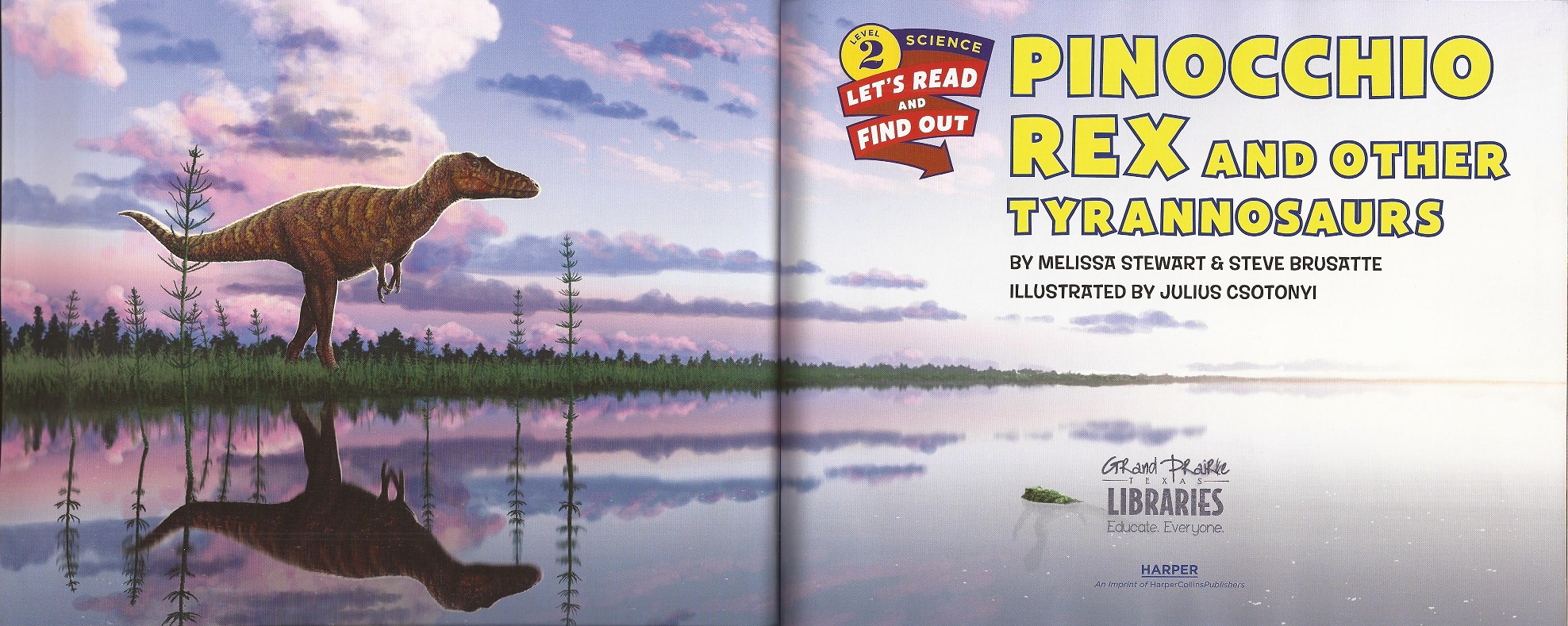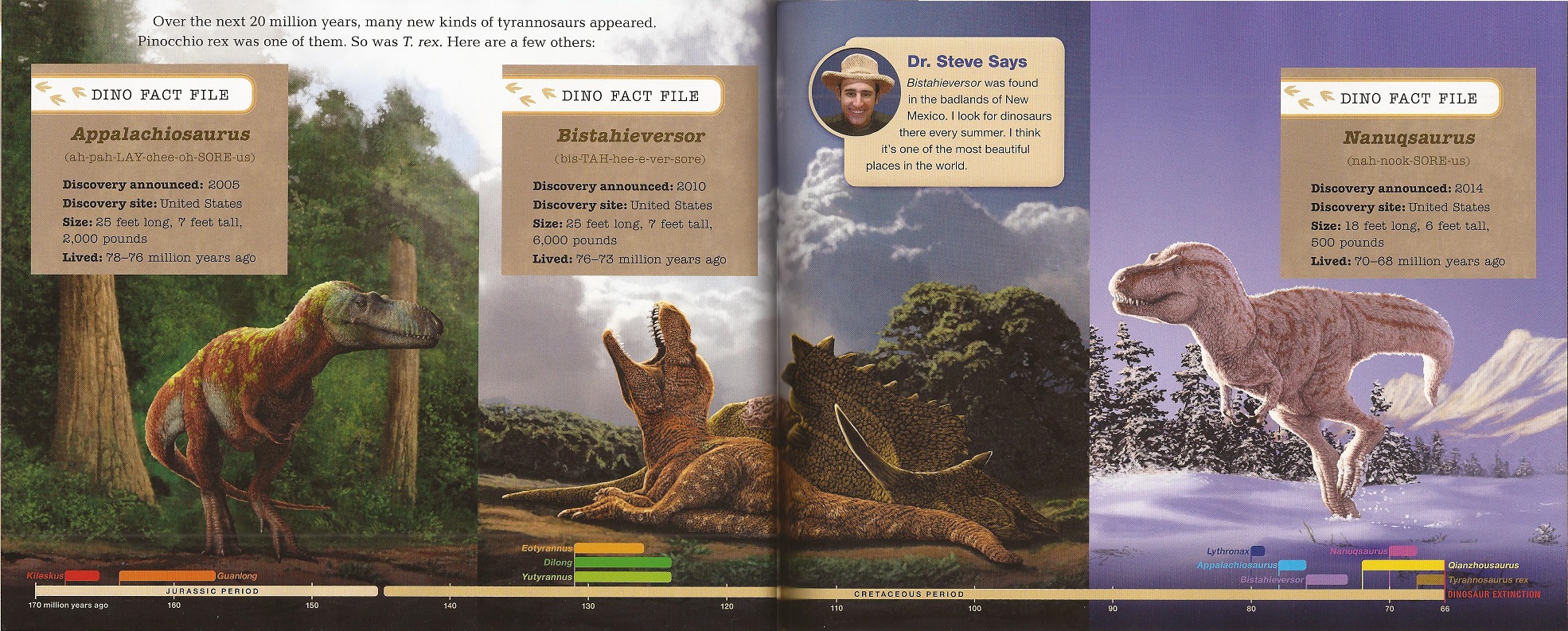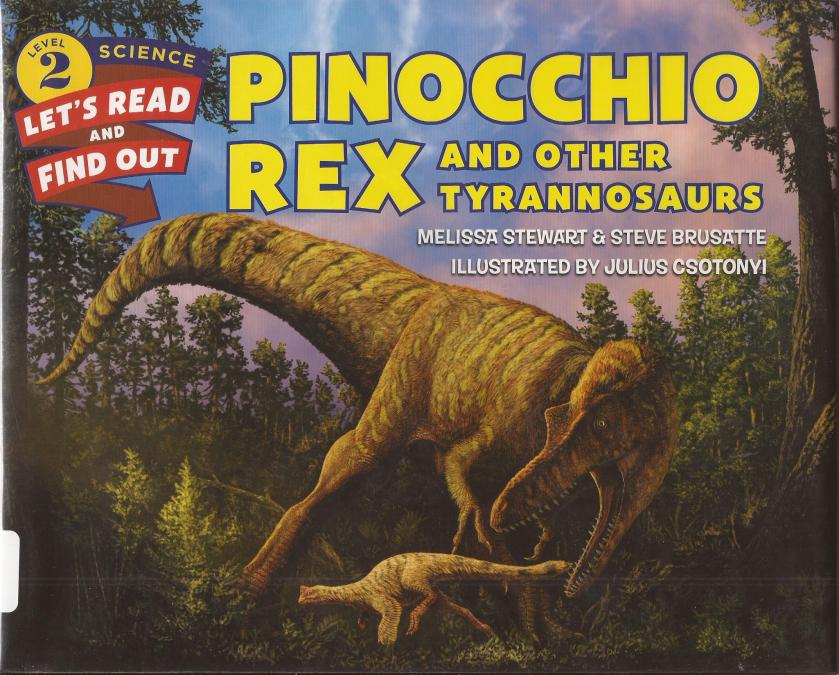After taking a detour into more adult-oriented fare with Cruisin’ The Fossil Coastline, then course-correcting back to very young readers with ROAR: A Dinosaur Tour, I figured I should go with something for more scientifically minded kids with today’s review. If you like interesting, flashy dinosaurs, but also learning more about the details of how they fit into the larger scheme of things, Pinocchio Rex and Other Tyrannosaurs fits the bill nicely!

This 2017 book, written by Melissa Stewart (who also authored Mega-Predators of the Past) & Steve Brusatte and illustrated by Julius Csotonyi, capitalizes on the relatively recent discovery of Qianzhousaurus, nicknamed “Pinocchio Rex” for its unusually long and skinny snout. Using the hook of a strange and interesting new species, it launches into an overview of the tyrannosaur family as a whole, with eleven different species featured. It gives a very good sense of the breadth of tyrannosaur diversity and evolution. We see tyrannosaurs of every size and shape, from the smallest, earliest members of the lineage, to the last and largest in the form of Tyrannosaurus rex itself. As the authors introduce us to each species, they add their names to a timeline at the bottom of the page, allowing the reader to follow their changes over time.

I found a couple odd omissions from the text that I felt could have improved the book. Most significantly, Timurlengia notably does not appear, despite the fact that Brusatte himself had described it the year before this book’s release. Without it, a large stretch of the mid-Cretaceous and a critical transitional phase in tyrannosaur evolution goes unaccounted for. I can appreciate the limits of the tight turnaround time in publication, but I should think that Brusatte’s insider knowledge could have circumvented that. (EDIT: Dr. Steve informs me that the book was actually finished well before the publication of Timurlengia! I had no idea the turnaround time was that long in publication!)
One other minor criticism I have concerns the location data on the featured dinosaurs. I felt that the spread featuring Appalachiasaurus, Bistahieversor, and Nanuqsaurus practically begs to be interpreted as a demonstration of the differences between members of the same family in different environments (eastern US, western US, and Alaska, respectively), but this possible point is somewhat blunted by the fact that each only has “United States” listed as its region.

Julius Csotonyi provides fantastic illustrations as always. He has an excellent eye for detail, and really knows how to make his subjects both interesting and believable. All the dinosaurs in this book sport a full coat of plumage, as seemed likely at the time. Studies published just this year have suggested that the larger and later species of tyrannosaurs had patchier coats, or even lost their feathers, though some have disputed this as well.
I particularly enjoyed the illustration of the original unveiling of AMNH 5027, the particular skeleton that resides in the American Museum of Natural History (the silhouette of which incidentally graces the world famous Jurassic Park logo!). Too few popular books include illustrations of important moments in the history of paleontology, especially anything after the turn of the 20th Century. It helps things feel more grounded when one can think of these skeletons as coming from a real place and time, discovered by real people.

In a similar vein, I really appreciated the “Meet Dr. Steve” section on pages 32-33 near the end of the book. Popular books also seem to have a bit of a blind spot when it comes to the actual people who discover and describe the dinosaurs such books love to feature. Ostensibly such books are meant to be educational and inspire an interest in science among kids, but I find that celebration of the actual scientists does just as much to engage people as learning about the dinosaurs themselves. Greater familiarity with the workers in the field can never hurt; in fact I think it makes paleontology and science in general seem all that much more accessible!

Speaking of paleontologists, before I wrap up, I feel I must acknowledge the passing on October 8 of Junchang Lü, the scientist who introduced Qianzhousaurus to the world. He had an incredible work ethic, and described countless new species. I hadn’t even realized he was the original scientist behind “Pinocchio Rex” until I started reviewing this book. His colleagues reminisce that he would often semi-jokingly nag them to finish up whatever projects they themselves were working on so that he could build off them. For more information on his life, Richard Conniff provides a memorial for Junchang Lü over at Scientific American.
On that somber note, I might as well finish off this review. Pinocchio Rex and Other Tyrannosaurs earns my recommendation for any kid interested in gaining a more in-depth understanding of the most famous of dinosaur families. Some may feel Tyrannosaurus rex is over-played, but placed within the context of its close relatives, it becomes fresh and exciting once again. The book describes itself as meant for kids in the primary grades beyond kindergarten. I’d say kids in the 8-12 range would likely get the most out of it, though any paleoart enthusiast can at least enjoy it for the illustrations! I give this the Dino Dad Stomp of Approval! You can find it here on Amazon. (I also recommend checking out Stewart’s more recent book Mega-Predators of the Past, as well as other books Csotonyi has illustrated, such as Discovering Sharks and Dino World: A 3-D Prehistoric Dinosaur Pop-Up Book.)



5 comments